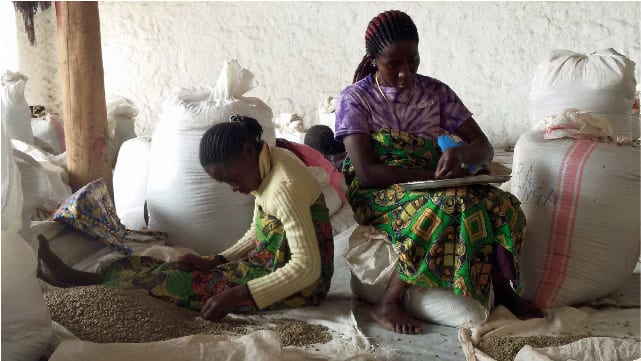The Origin Story of Indonesian Rainforest Coffee. What is the difference between Rainforest Coffee and ordinary Coffee?

Professional coffee knowledge exchange more coffee bean information please follow the coffee workshop (Wechat official account cafe_style)
Wu Tzu-Yu, who graduated from the law department of National Taiwan University, gave up the broad road of lawyers and magistrates to participate in post-disaster reconstruction work in his hometown Dongshi after the 921 earthquake in 1988. after the 2004 tsunami in South Asia, he visited Indonesia's worst-hit Aceh province, and then participated in the environmental sustainable development program in the village of Bakkara in northern Sumatra, where he worked as a volunteer for several years.
Wu Ziyu learned locally that Indonesia produces 350000 metric tons of coffee a year and is the fourth largest exporter of raw beans in the world, while the rainforest in Sumatra is disappearing at a rate of 2 million hectares a year. She is even more surprised to realize that at this stage, Taiwan's living consumption depends on global resources. it takes 29 Taiwan to support it. "We are all environmental 'exploiters'" coupled with the price of coffee is determined by the international futures market. The profit of a can of coffee is about 55%, which falls into large multinational food enterprises such as Nestle, while retailers get about 25%. Exporters get 10%, as much as the farmers who pay the most labor, so that the living standards of many local coffee farmers are on the poverty line defined by the United Nations.
As a developed country after economic take-off, does Taiwan bear some responsibility to the earth and to the poorer countries? Wu Ziyu decided to connect Taiwan and Indonesia through fair trade in coffee to care for rainforest conservation and farmers and students in Sumatra.
Core idea: what's the difference between rainforest coffee and fair trade in general?
Place of origin trading channel this is the process through which coffee is produced, acquired, and then exported to consumers: in coffee producing areas, the first-line purchasers are cooperatives made up of farmers, usually controlling 20-40 farmers. farmers sell beans to the same purchaser all their lives. Usually only the opinion leaders in the village and those with machinery and equipment can become front-line purchasers, while the only thing the average farmer can master is to work hard in the coffee garden.
At present, almost all the Fairtrade coffee sold in Taiwan is purchased from general large Fairtrade organizations, such as FLO (Fairtrade International). FLO carries out Fairtrade certification for front-line buyers and then sells its coffee to manufacturers in cooperation with FLO.
Wu Ziyu observed that local cooperatives set up by the International Fair Trade Organization are often misappropriated by a small number of leaders or colluded with front-line acquirers, while farmers who should be distributed with rewarded profits are excluded. Therefore, what Wu Ziyu Rainforest Coffee needs to do is to go directly to the producing areas to purchase directly from farmers. "Rainforest Coffee follows the social enterprise route, where profits are not distributed to shareholders, but to local farmers."
Fair trade is the starting point, and the follow-up "rainforest project" will devote the surplus of rainforest coffee to the care and restoration of tropical rainforest.
END
Important Notice :
前街咖啡 FrontStreet Coffee has moved to new addredd:
FrontStreet Coffee Address: 315,Donghua East Road,GuangZhou
Tel:020 38364473
- Prev

Current situation of coffee industry in Congo | how about coffee in Congo, a big coffee country in Africa?
Professional coffee knowledge exchange more coffee bean information Please follow the coffee workshop (Wechat official account cafe_style) the Democratic Republic of the Congo (DRC) is rich in resources, but due to years of civil war, lack of stability and infrastructure. The Congolese coffee industry used to flourish, but now it lacks a development strategy to help farmers realize the great potential of Congolese coffee and improve their health.
- Next

In the first quarter of 2019, Indonesia's coffee export exceeded 22.86 million US dollars. Is Aceh coffee good?
Professional coffee knowledge exchange more coffee bean information Please follow the coffee workshop (Wechat official account cafe_style) in the first quarter of 2019, coffee exports from the plateau production in central Aceh exceeded 311.04%, totaling US $22.86 million, a sharp increase over the same period in 2018. Wahyudin, director of the Central Bureau of Statistics (BPS) of Aceh, told reporters in Wanda Aceh: today
Related
- Does Rose Summer choose Blue, Green or Red? Detailed explanation of Rose Summer Coffee plots and Classification in Panamanian Jade Manor
- What is the difference between the origin, producing area, processing plant, cooperative and manor of coffee beans?
- How fine does the espresso powder fit? how to grind the espresso?
- Sca coffee roasting degree color card coffee roasting degree 8 roasting color values what do you mean?
- The practice of lattes: how to make lattes at home
- Introduction to Indonesian Fine Coffee beans-- Java Coffee producing area of Indonesian Arabica Coffee
- How much will the flavor of light and medium roasted rose summer be expressed? What baking level is rose summer suitable for?
- Introduction to the characteristics of washing, sun-drying or wet-planing coffee commonly used in Mantenin, Indonesia
- Price characteristics of Arabica Coffee Bean Starbucks introduction to Manning Coffee Bean Taste producing area Variety Manor
- What is the authentic Yega flavor? What are the flavor characteristics of the really excellent Yejasuffi coffee beans?

